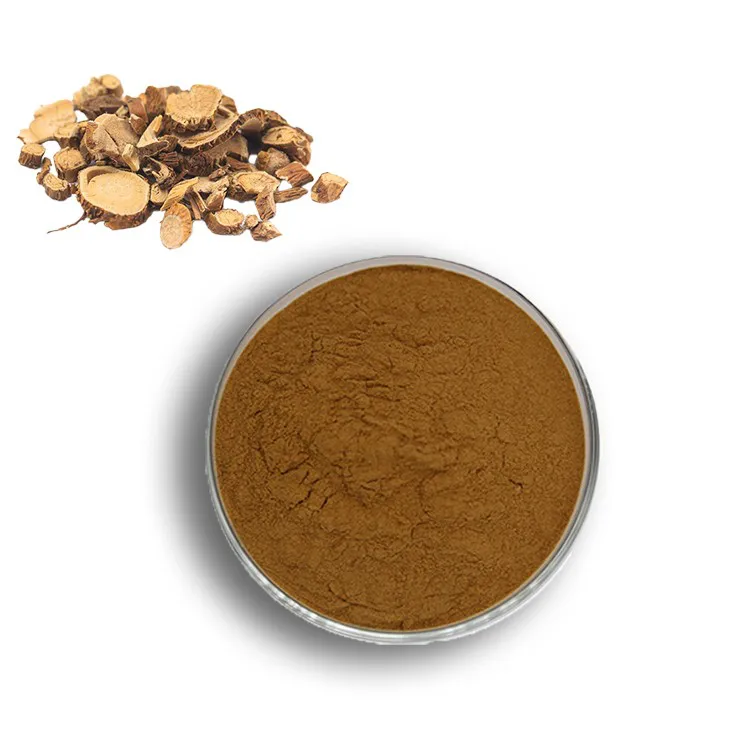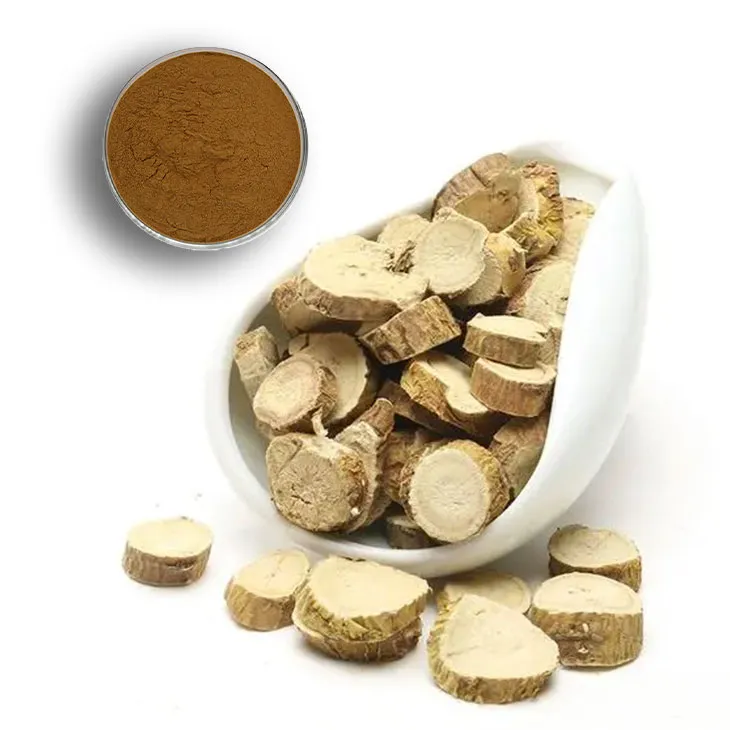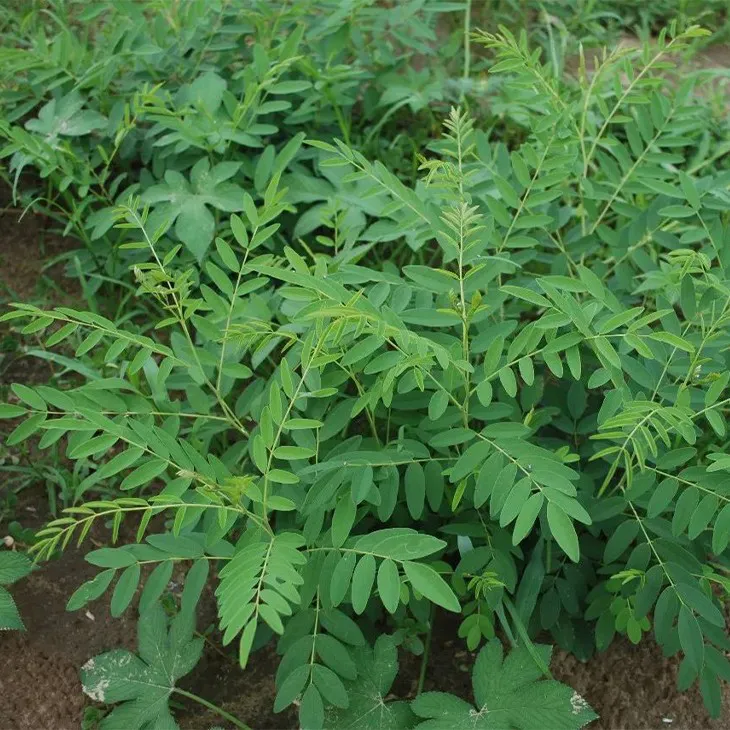- 0086-571-85302990
- sales@greenskybio.com
Supercritical Carbon Dioxide Extraction of Sophora flavescens Root Extract.
2024-11-29

1. Introduction
Supercritical carbon dioxide extraction has become a very important and promising technique in the field of natural product extraction. Sophora flavescens is a well - known medicinal plant in traditional Chinese medicine. Its root contains a variety of bioactive compounds. Extracting the Sophora Flavescens Root Extract efficiently and with high quality is of great significance for its application in medicine, cosmetics, and food industries.

2. Supercritical Carbon Dioxide Extraction: An Overview
Supercritical carbon dioxide (SC - CO₂) is a state of carbon dioxide where it has properties between those of a gas and a liquid. At supercritical conditions (above the critical temperature of 31.1°C and critical pressure of 7.38 MPa), carbon dioxide exhibits unique properties such as high diffusivity, low viscosity, and high density. These properties make it an excellent solvent for extraction.
Advantages over traditional extraction methods:
- Higher extraction efficiency: SC - CO₂ can penetrate into the plant matrix more effectively, resulting in a higher yield of the desired extract compared to traditional solvent extraction methods. For example, in the extraction of Sophora flavescens root, it can extract more bioactive components in a shorter time.
- Better selectivity: By adjusting the extraction conditions such as pressure and temperature, it is possible to selectively extract specific compounds from the Sophora flavescens root. This is in contrast to traditional methods where a mixture of compounds is often obtained, and further purification steps are required.
- Absence of solvent residues: Since carbon dioxide is a gas at normal conditions, after the extraction process, it can be easily removed from the extract by simply reducing the pressure. This ensures that there are no harmful solvent residues in the final product, which is especially important for applications in food and cosmetics.

3. Extraction Process Parameters for Sophora Flavescens Root Extract
3.1 Pressure
Pressure is one of the most critical parameters in supercritical carbon dioxide extraction. In the extraction of Sophora Flavescens Root Extract, different pressures can lead to different extraction yields and compositions. Generally, as the pressure increases, the solubility of the compounds in the root in supercritical carbon dioxide also increases. However, there is an optimal pressure range. For example, pressures in the range of 10 - 30 MPa are often studied for Sophora flavescens root extraction. At lower pressures, some of the less soluble but important bioactive compounds may not be fully extracted. At extremely high pressures, it may lead to the extraction of unwanted compounds or may cause equipment problems.
3.2 Temperature
Temperature also plays an important role. In the supercritical region, increasing the temperature can change the density and diffusivity of carbon dioxide. For Sophora flavescens root extraction, temperatures typically range from 40 - 60°C. At lower temperatures, the extraction process may be too slow. However, if the temperature is too high, it may cause degradation of some thermally sensitive compounds in the root. For example, some alkaloids in Sophora flavescens root may be affected by high temperatures.
3.3 Extraction Time
The extraction time is another factor to consider. Longer extraction times may seem to increase the yield, but it may also lead to the extraction of more impurities. In the case of Sophora flavescens root extraction, extraction times usually range from 1 - 3 hours. Shorter extraction times may not be sufficient to extract all the desired compounds, while longer times may not be cost - effective and may reduce the quality of the extract.

4. Chemical Composition of Sophora flavescens Root Extract Obtained by Supercritical Carbon Dioxide Extraction
The Sophora flavescens root extract obtained by supercritical carbon dioxide extraction contains a variety of chemical components.
- Alkaloids: Alkaloids are one of the main bioactive components in Sophora flavescens root. Compounds such as matrine and oxymatrine are present in the extract. These alkaloids have been reported to have various pharmacological activities, such as anti - inflammatory, anti - microbial, and anti - cancer properties.
- Flavonoids: Flavonoids are also found in the extract. They contribute to the antioxidant activity of the extract. Some of the flavonoids may play a role in protecting cells from oxidative damage, which is beneficial for applications in cosmetics and food.
- Triterpenoids: Triterpenoids are another group of compounds in the extract. They may have potential health - promoting effects, such as modulating the immune system.
5. Potential Bioactivities of Sophora flavescens Root Extract
5.1 In Medicine
- Anti - inflammatory activity: The alkaloids and flavonoids in the Sophora flavescens root extract may contribute to its anti - inflammatory effects. They can inhibit the production of inflammatory mediators, which is beneficial for the treatment of inflammatory diseases such as arthritis.
- Anti - microbial activity: The extract has been shown to have activity against various microorganisms, including bacteria and fungi. This makes it a potential candidate for the development of new antimicrobial agents.
- Anti - cancer potential: Some studies have suggested that certain compounds in the extract, especially alkaloids, may have anti - cancer properties. They may act by inhibiting cancer cell proliferation or inducing apoptosis in cancer cells.
5.2 In Cosmetics
- Antioxidant function: The flavonoids in the extract can scavenge free radicals, which helps to prevent skin aging. It can be used in anti - aging cosmetics products.
- Skin whitening effect: Some components in the extract may inhibit the production of melanin, which can lead to a skin - whitening effect, making it suitable for skin - whitening cosmetics.
5.3 In Food
- Preservative potential: The anti - microbial activity of the extract can be utilized to preserve food, reducing the need for chemical preservatives.
- Nutritional value: The presence of various bioactive compounds in the extract can add nutritional value to food products. For example, the antioxidant properties can help protect the nutritional content of food during storage.
6. Conclusion
Supercritical carbon dioxide extraction is a very effective method for obtaining Sophora flavescens root extract. It has many advantages over traditional extraction methods, including higher extraction efficiency, better selectivity, and the absence of solvent residues. By carefully controlling the extraction process parameters such as pressure, temperature, and extraction time, a high - quality extract with a rich chemical composition can be obtained. The extract has significant potential bioactivities in the fields of medicine, cosmetics, and food, which makes it a very valuable natural product. Future research should focus on further optimizing the extraction process, exploring more bioactivities, and promoting its wide application in various industries.
FAQ:
What are the main advantages of supercritical carbon dioxide extraction for Sophora flavescens root extract?
The main advantages include higher extraction efficiency, better selectivity, and no solvent residues. Higher extraction efficiency means more of the desired components from the Sophora flavescens root can be extracted compared to some traditional methods. The better selectivity allows for the extraction of specific compounds, and the absence of solvent residues makes the extract purer and more suitable for applications in medicine, cosmetics, and food.
How do extraction process parameters like pressure, temperature, and extraction time affect the supercritical carbon dioxide extraction of Sophora flavescens root extract?
Pressure, temperature, and extraction time are crucial parameters. Higher pressure generally increases the solubility of the components in supercritical carbon dioxide, leading to a higher extraction yield. Temperature also affects solubility; an appropriate temperature range can optimize the extraction process. Longer extraction time may increase the amount of extract obtained, but there may be a point of diminishing returns. Each parameter needs to be carefully adjusted to achieve the best extraction results.
What are the potential bioactivities of the Sophora flavescens root extract obtained by supercritical carbon dioxide extraction?
The Sophora flavescens root extract may have various potential bioactivities. It could have antibacterial, anti - inflammatory, antioxidant, and other properties. These bioactivities make it valuable in medicine for treating certain diseases, in cosmetics for skin health improvement, and in food for preservation or as a functional ingredient.
Why is supercritical carbon dioxide extraction considered an environmentally friendly technique?
Supercritical carbon dioxide extraction is considered environmentally friendly because carbon dioxide is a non - toxic, non - flammable gas. It is also easily available and recyclable in the extraction process. Unlike some traditional solvents, it does not produce harmful waste or residues, reducing environmental pollution.
How can the chemical composition of the Sophora flavescens root extract obtained by supercritical carbon dioxide extraction be analyzed?
The chemical composition can be analyzed using various techniques. Gas chromatography - mass spectrometry (GC - MS) can be used to identify volatile components. High - performance liquid chromatography (HPLC) is suitable for analyzing non - volatile compounds. Spectroscopic methods such as infrared spectroscopy (IR) can also provide information about the functional groups present in the extract.
Related literature
- Supercritical Fluid Extraction of Natural Products"
- "Advances in Sophora flavescens Research"
- "Application of Supercritical Carbon Dioxide in Plant Extracts"
- ▶ Hesperidin
- ▶ citrus bioflavonoids
- ▶ plant extract
- ▶ lycopene
- ▶ Diosmin
- ▶ Grape seed extract
- ▶ Sea buckthorn Juice Powder
- ▶ Beetroot powder
- ▶ Hops Extract
- ▶ Artichoke Extract
- ▶ Reishi mushroom extract
- ▶ Astaxanthin
- ▶ Green Tea Extract
- ▶ Curcumin Extract
- ▶ Horse Chestnut Extract
- ▶ Other Problems
- ▶ Boswellia Serrata Extract
- ▶ Resveratrol Extract
- ▶ Marigold Extract
- ▶ Grape Leaf Extract
- ▶ blog3
- ▶ Aminolevulinic acid
- ▶ Cranberry Extract
- ▶ Red Yeast Rice
- ▶ Red Wine Extract
-
Eucommia Ulmoides Extract
2024-11-29
-
Stevia Extract
2024-11-29
-
Chaste Berry Extract
2024-11-29
-
Chasteberry Extract
2024-11-29
-
Saw Palmetto Extract
2024-11-29
-
Polygonum Cuspidatum Extract
2024-11-29
-
White mustard seed extract
2024-11-29
-
Wheat Germ Extract
2024-11-29
-
Lotus leaf extract
2024-11-29
-
Bitter Melon Extract
2024-11-29





















